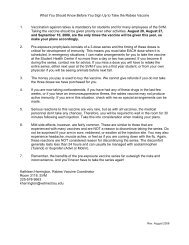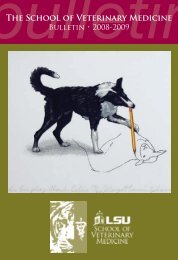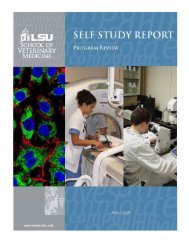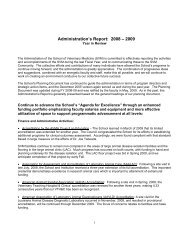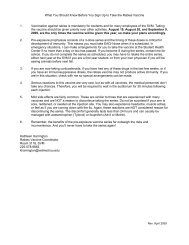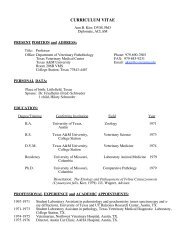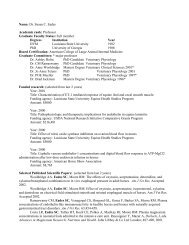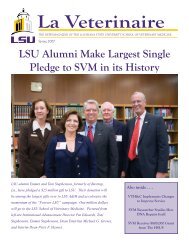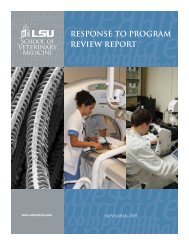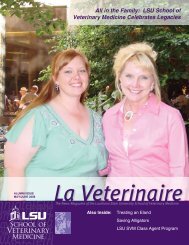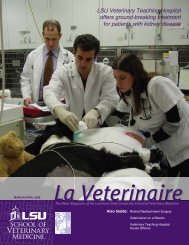Enhancing the Quality and Reliability <strong>of</strong> Diagnostic ImmunocytochemistryElisabeth Peters*, Victor E. ValliCollege <strong>of</strong> <strong>Veterinary</strong> <strong>Medicine</strong>, University <strong>of</strong> Illinois at Urbana-ChampaignDiagnostic immunocytochemistry is frequently conducted on routine submissions from schools <strong>of</strong> veterinarymedicine as well as local practitioners. Cytology is practical because it <strong>of</strong>fers valuable management information for manytypes <strong>of</strong> lesions at very reasonable cost, but it requires skilled diagnostic interpretation. A recurring problem with this serviceis that freshly made blood and cytological smears with heavy cellular spreads tend to detach from the slides in the stainingprocess. For our study, tissues were collected from animals that were electively euthanized. The tissues were selected fromsites where inflammatory, hyperplastic, and neoplastic lesions commonly occur such as the lymph nodes, spleen, bonemarrow, skin, thyroid, liver, pancreas, and adrenal gland. Dispersed cells were collected into a transport media and cytologicpreparations <strong>of</strong> these tissues were used in the study along with specimens submitted to the veterinary teaching hospital. Twomethods <strong>of</strong> fixation were used prior to staining. These include drying the slide for a day followed by immersion in acetonefor 5 minutes, or immediate fixation in 10% formalin for 30 seconds. Formalin fixation gives better cell preservation andadhesion, but prevents the diagnostic antibodies from penetrating the cell membranes and requires an antigen retrievalprocess. This retrieval is achieved by boiling the slide preparations for 5 minutes in a pressurized chamber containing citratebuffer at pH 6. We have established base protocols for CD3, CD20, CD79, cytokeratin, and vimentin. Other antibodies inadvanced development include CD4, CD8á, CD8â, CD172, FIP, FeLV, thyroglobulin, myeloperoxidase, chromogranin, andsynaptophysin. The results <strong>of</strong> this study will permit those using immunocytochemistry to access a wider array <strong>of</strong> reagentsand expand their capabilities for making a specific diagnosis.Quantifying the effect <strong>of</strong> CD30 signaling via NFkB in the neoplastically transformed cells on Marek’sDisease Virus Meq transcriptionMelissa Pflueger*, Dusan Kunec, Dr. Shane BurgessCollege <strong>of</strong> <strong>Veterinary</strong> <strong>Medicine</strong>, Mississippi <strong>State</strong> University, Mississippi <strong>State</strong>, MSMarek’s Disease herpesvirus (MDV) is a naturally occurring oncogenic virus causing T-cell lymphomas in poultryas well as a unique natural animal model for CD30 (“Hodgkin’s disease antigen”) over-expressing human lymphomas. CD30is thought to contribute to the neoplastic transformation <strong>of</strong> lymphocytes via its signaling pathway which includes the NFkBtranscription factor family. The MDV putative “oncogene” Meq promotes expression <strong>of</strong> the CD30 antigen. We hypothesizethat CD30 signaling via NFkB in turns promotes Meq transcription setting up a positive feedback loop. To test our hypothesiswe will examine whether chicken NFkB can promote transcription from the Meq promoter in vitro. Our aims here were t<strong>of</strong>irst construct recombinant plasmids expressing NFkB is<strong>of</strong>orms p50, p65, p100 and p105 and a plasmid in which the Meqpromoter is cloned 5’ <strong>of</strong> the GFP gene. These will be used in co-transfection experiments to identify whether or not the NFkBis<strong>of</strong>orms are active at the Meq promoter.Characterization <strong>of</strong> Carboxylesterases Derived from Lean and Obese/Atherosclerotic Rat LiverLloyd V. Reitz*, Tim M. Streit, Abdolsamad Borazjani, Alison C. Elder, Matthew K. RossCollege <strong>of</strong> <strong>Veterinary</strong> <strong>Medicine</strong>, Mississippi <strong>State</strong> University, Mississippi <strong>State</strong>, MS. Department <strong>of</strong>Environmental <strong>Medicine</strong>, University <strong>of</strong> Rochester, Rochester, NY.Carboxylesterases (CEs) are promiscuous members <strong>of</strong> a xenobiotic-detoxifying enzyme family that hydrolyzescompounds with ester bonds. CEs are primarily found in liver and major is<strong>of</strong>orms in rat are termed Hydrolase A andHydrolase B. In this study we examined the levels <strong>of</strong> hepatic CE activities and protein (Hydrolase A) in lean (+/?) andobese/atherosclerotic (cp/cp) rats during basal conditions and following exposure to concentrated ultrafine particulates(CUPs). For biochemical study CEs were extracted from rat liver in the microsomal fraction (RLM). Hydrolytic reactionscatalyzed by CEs utilized the following esterified substrates: para-nitrophenol valerate, 4-methylumbelliferyl acetate, andselect pyrethroid insecticides. The levels <strong>of</strong> CE activities in the lean and cp/cp RLMs were not significantly different underbasal conditions (control). However, following exposure to CUPs, hydrolytic activities in cp/cp RLM were significantlyreduced compared to the lean RLM. Western blots <strong>of</strong> these same microsomal proteins demonstrated that the cp/cp RLMs hadsignificantly reduced levels <strong>of</strong> Hydrolase A protein compared to lean RLMs. When hydrolytic activities <strong>of</strong> lean RLMs fromcontrol and CUP groups were compared, evidence <strong>of</strong> robust CE induction was observed. In contrast, no significantdifferences in hydrolytic activities were observed between the cp/cp RLMs from the exposed and control groups. Thus, theseresults indicate an induction response is occurring in the lean animals exposed to the CUPs, while this response is blunted inthe cp/cp animals. In conclusion, the CE xenobiotic-detoxifying activities <strong>of</strong> the liver appear to be linked to health statuswith obesity being a prime indicator <strong>of</strong> decreased activity following xenobiotic challenge. [Trainee stipend supported byNIH-NCRR RR070710].106
Comparison <strong>of</strong> equine neurokinin-A receptor protein in healthy and RAO-affected horsesMichael Rossi, Ginger Robertson, Changaram VenugopalPharmacology Laboratory, LSU <strong>School</strong> <strong>of</strong> <strong>Veterinary</strong> <strong>Medicine</strong>, Baton Rouge, LA 70803Neurokinin-A (NK-A), a member <strong>of</strong> the tachykinin family <strong>of</strong> neuropeptides, has been reported to be an excitatoryairway neurotransmitter and an inflammatory mediator <strong>of</strong> airway hyperreactivity in man and guinea pigs. However, this hasnot been examined in horses. NK-A produces its effect by combining with NK-2 receptors. Our previous studies haveshown that bronchial rings <strong>of</strong> horses with recurrent airway obstruction (RAO), an airway hyperreactivity disease, respondedsignificantly greater than those <strong>of</strong> healthy horses suggesting alteration <strong>of</strong> NK-2 receptors in the diseased animals. Therefore,we hypothesized that the increased responsiveness <strong>of</strong> RAO- affected horses is due to the upregulation <strong>of</strong> NK-2 receptors inthe tissues. The objective <strong>of</strong> this study is to determine and quantify receptor protein for comparison between healthy horsesand horses affected with recurrent airway obstruction. To attain the objective, we used purified PCR products using primersdesigned from known receptor sequences in other species.CHO cells were transfected with plasmids containing the PCR products. The cells were incubated to express theprotein <strong>of</strong> interest. The cells were then lysed using a standard RIPA buffer with the protease inhibitor, aprotonin. This wascentrifuged and the supernatant was extracted which was used for Western blot analysis. The samples were run on a 15%Tris-HCl gel at 20 mA for 2 hours. Then the gel was transferred to a nitrocellulose membrane overnight. Primary rabbitpolyclonal antibody to the neurokinin-A receptor protein was added to the blot, which was followed by an alkalinephosphatase labeled secondary antibody specific against rabbit. The substrate BCIP was added to visualize the protein. Thebands were observed on the nitrocellulose membrane however, they were not confirmed by adding antibodies. The inabilityto confirm the NK receptor protein could be due to several factors such as the antibody we used, the quantity <strong>of</strong> the sample,dilution <strong>of</strong> the antibody or the protein we are testing. Therefore, we are planning to repeat the experiments to verify all thesepossibilities.Role <strong>of</strong> Mitochondrial Stress Signaling in Pancreatic Tumor InvasionMiriam Sadek*, Gopa Biswas, Narayan G. AvadhaniDepartment <strong>of</strong> Animal Biology, <strong>School</strong> <strong>of</strong> <strong>Veterinary</strong> <strong>Medicine</strong>, University <strong>of</strong> Pennsylvania, Philadelphia, PAIn addition to the known functional roles <strong>of</strong> mitochondria which include cellular energy production and Ca2+homeostasis, the study <strong>of</strong> mitochondrial dysfunction is providing new insight into the mechanistic details <strong>of</strong> cancer, diabetes,and various degenerative diseases.Warburg’s hypothesis (Warburg, 1956) describing a role for mitochondrial dysfunction in carcinogenesis, hasinspired numerous experiments exploring specifically the impact <strong>of</strong> retrograde signaling on tumor progression through theinduction <strong>of</strong> invasive behavior. Retrograde signaling or mitochondrial signaling, is defined as cellular responses to changesin the functional state <strong>of</strong> mitochondria (Butow, Avadhani, 2004).Mitochondrial stress can be induced genetically, via partial depletion <strong>of</strong> mitochondrial DNA, or metabolically, bytreatment with mitochondrial-specific inhibitors such as CCCP (carbonyl cyanide m-chlorophenylhydrazone), or TCDD(2,3,7,8-tetrachlorodibenzo-p-dioxin) causing stress signaling associated with increased cytoplasmic-free Ca2+ anddisruption <strong>of</strong> mitochondrial membrane potential (Amuthan et al., 2001). The mitochondria-to-nucleus stress signaling thatensues has been shown to induce invasive and highly tumorigenic phenotypes in otherwise non-invasive C2C12 myoblastsand human pulmonary carcinoma A549 cells (Amuthan et al., 2001). Expression <strong>of</strong> a number <strong>of</strong> tumor-specific marker genesincluding cathepsin L, an extracellular matrix protease, TGF-b, epiregulin, and mouse melanoma antigen, is also induced(Butow, Avadhani, 2004).Mitochondrial stress-induced phenotypic changes with respect to invasive behavior and patterns <strong>of</strong> gene expressionhas been reversed in mtDNA-depleted C2C12 cells by restoration <strong>of</strong> mtDNA content, further establishing a role formitochondrial-stress induced signaling in tumorigenesis (Butow, Avadhani, 2004).Our objective is to attempt to confirm these findings by inducing mitochondrial stress in pancreatic carcinoma cellsand determining if there is stress induced invasiveness <strong>of</strong> the otherwise benign cancer cells. If our cells do become highlyproliferative and invasive, we will try and revert this condition by restoring mitochondrial ĵm (transmembrane potential),thereby restoring cytosolic free Ca2+ level, reversing the mitochondrial stress.Investigation <strong>of</strong> Predictors <strong>of</strong> Outcome for Canine Mast Cell TumorsAshley Shely, BS*; Jane D. Mount, PhD; Allison Vossmeyer, Deanalyn Reing, Elizabeth M. Whitley, DVM, PhDCollege <strong>of</strong> <strong>Veterinary</strong> <strong>Medicine</strong>, Auburn University, Auburn, Alabama 36849-5519Mast cell tumors (MCT) are the most common skin malignancy <strong>of</strong> dogs. The Patnaik grading system is used commonlyto categorize tumors based on histologic features. Most MCT are categorized as grade II, meaning that the cells are intermediatelydifferentiated. However, dogs with grade II MCTs have wide variations in lifespan, rate <strong>of</strong> recurrence, and overall cure. Toimprove the accuracy <strong>of</strong> prognostication <strong>of</strong> MCTs, we aim to use markers <strong>of</strong> proliferation and invasion to further categorize the107
- Page 1 and 2:
2006 MERCK/MERIALNATIONAL VETERINAR
- Page 6 and 7:
3:00-3:30 pm BreakNovel therapy for
- Page 8 and 9:
KEYNOTE SPEAKERRonald Veazey, D.V.M
- Page 10 and 11:
Mini Symposium II:Fish Research: A
- Page 12 and 13:
David G. Baker, D.V.M., M.S., Ph.D.
- Page 14 and 15:
Konstantin G. Kousoulas, Ph.D.Profe
- Page 16 and 17:
Joseph Francis, B.V.Sc., M.V.Sc., P
- Page 18 and 19:
dogs with cancer, the potential rol
- Page 20 and 21:
2006 MERCK/MERIALVETERINARY SCHOLAR
- Page 22 and 23:
YOUNG INVESTIGATOR AWARD HONORABLE
- Page 24 and 25:
Mammary epithelial-specific deletio
- Page 26 and 27:
2006 MERCK/MERIALVETERINARY SCHOLAR
- Page 28:
Variation in Q-Tract Length of the
- Page 34:
Novel therapy for humoral hypercalc
- Page 38:
ALTERNATE:Micron-scale membrane sub
- Page 42 and 43:
ABSTRACT TITLES LISTED BY CATEGORY
- Page 44 and 45:
19. A pilot study of cigarette smok
- Page 46 and 47:
36. Development of a murine in vitr
- Page 48 and 49:
ABSTRACT TITLES LISTED BY CATEGORY
- Page 50 and 51:
71. Identification and characteriza
- Page 52 and 53:
85. Age and Gender Influence Ventil
- Page 54 and 55:
ABSTRACT TITLES LISTED BY CATEGORY
- Page 56 and 57: 2006 MERCK/MERIALVETERINARY SCHOLAR
- Page 58 and 59: 10. Preliminary estimation of risk
- Page 60 and 61: ABSTRACT TITLES LISTED BY CATEGORY
- Page 62 and 63: 47. Osteoprotegerin and Receptor Ac
- Page 64 and 65: 61. A Comparison of Interaction Pat
- Page 66 and 67: ABSTRACT TITLES LISTED BY CATEGORY
- Page 68 and 69: ABSTRACT TITLES LISTED BY CATEGORY
- Page 70 and 71: ABSTRACT TITLES LISTED BY CATEGORY
- Page 72 and 73: 2006 MERCK/MERIALVETERINARY SCHOLAR
- Page 74 and 75: used to label avian heterophils for
- Page 76 and 77: obtained via analysis of time and d
- Page 78 and 79: 0.71mg/dL; p=0.001). Values for hem
- Page 80 and 81: mass and fecundity in prespawning w
- Page 82 and 83: Equine Hoof Laminae Tissue Collecti
- Page 84 and 85: Aspiration Pneumonia in DogsDavid A
- Page 86 and 87: Distortion Product Otoacoustic Emis
- Page 88 and 89: tyrosine phosphorylation is measure
- Page 90 and 91: the gravid and non-gravid females t
- Page 92 and 93: egulatory function as its ortholog,
- Page 94 and 95: PATHOLOGY, TOXICOLOGY, AND ONCOLOGY
- Page 96 and 97: Markers of Oxidative Stress in plas
- Page 98 and 99: has been isolated from all samples
- Page 100 and 101: Matrix metalloproteinase secretion
- Page 102 and 103: Reproductive performance, neonatal
- Page 104 and 105: control to determine the efficiency
- Page 108 and 109: grade II MCTs into groups with good
- Page 110 and 111: Transcriptional Regulation of the I
- Page 112 and 113: MICROBIOLOGY AND IMMUNOLOGY (SESSIO
- Page 114 and 115: colonization of the mutant and 6 re
- Page 116 and 117: digestive tracts of these and other
- Page 118 and 119: 100 pfu BRSV. The results show that
- Page 120 and 121: Inhibition of Microneme Secretion i
- Page 122 and 123: Adherent bacilli were present in th
- Page 124 and 125: isolated to analyze cytokine gene e
- Page 126 and 127: purified, viral RNA was extracted a
- Page 128 and 129: The effects of co-engagement of TLR
- Page 130 and 131: Occurrence of Leptospira Vaccine Fa
- Page 132 and 133: undifferentiated catecholaminergic
- Page 134 and 135: the concept that the greater detoxi
- Page 136 and 137: quantitative PCR using gene targets
- Page 138 and 139: Rotenone Induced Dopamine Neuron De
- Page 140 and 141: decrease in serum cortisol, with a
- Page 142 and 143: and detrimental impacts on the brai
- Page 144 and 145: actions of cells prior to embryo de
- Page 146 and 147: Utilizing cDNA Subtraction to Exami
- Page 148 and 149: expression in unilaterally pregnant
- Page 150 and 151: Salmonella is increased. Poultry sa
- Page 152 and 153: exports. The estimated prevalence o
- Page 154 and 155: eeding grounds near Minnedosa, MB s
- Page 156 and 157:
(PBMC) were isolated using commerci
- Page 158 and 159:
2006 MERCK/MERIALVETERINARY SCHOLAR
- Page 160 and 161:
Trainees acquire in-depth knowledge
- Page 162 and 163:
comparative pathology and/or resear
- Page 164 and 165:
Department of Veterinary Bioscience
- Page 166 and 167:
PhD, Director, Center for Comparati
- Page 168 and 169:
2006 MERCK/MERIALVETERINARY SCHOLAR
- Page 170 and 171:
MICHIGAN STATEUNIVERSITYJames Crawf
- Page 172:
UNIVERSITY OFPENNSYLVANIALindsay Th



